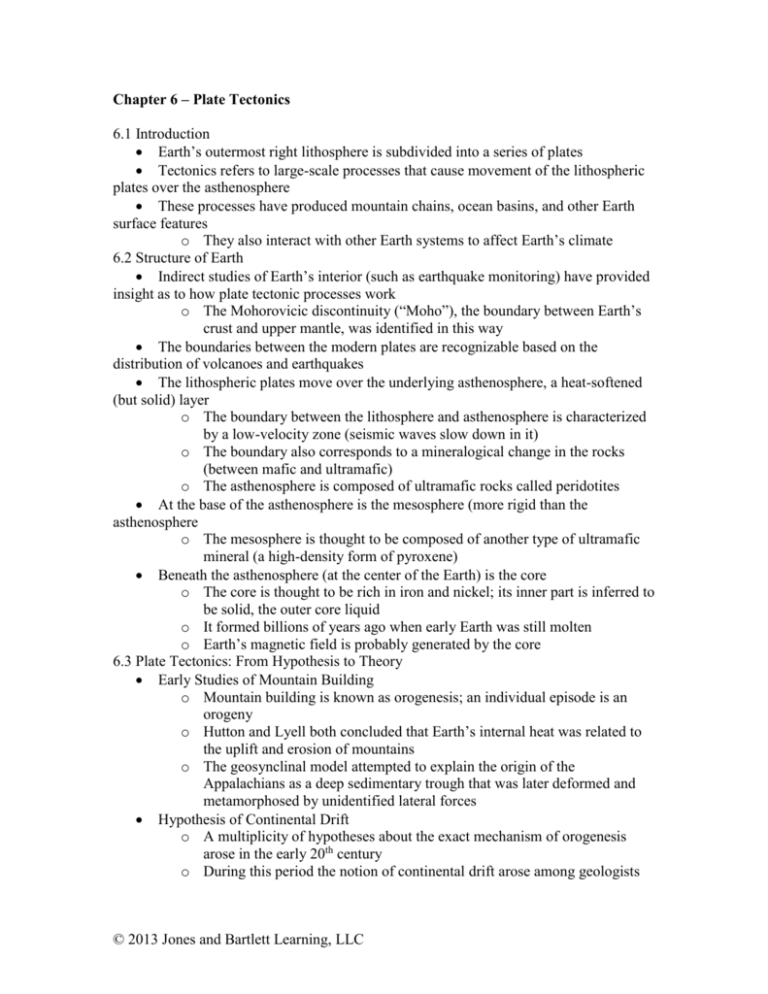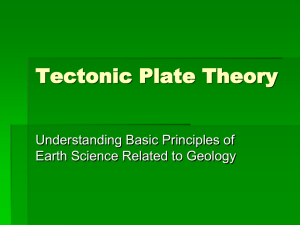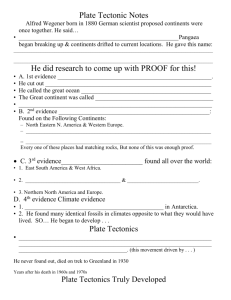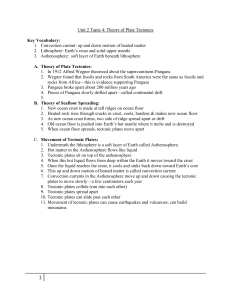Chapter 6: Plate Tectonics
advertisement

Chapter 6 – Plate Tectonics 6.1 Introduction Earth’s outermost right lithosphere is subdivided into a series of plates Tectonics refers to large-scale processes that cause movement of the lithospheric plates over the asthenosphere These processes have produced mountain chains, ocean basins, and other Earth surface features o They also interact with other Earth systems to affect Earth’s climate 6.2 Structure of Earth Indirect studies of Earth’s interior (such as earthquake monitoring) have provided insight as to how plate tectonic processes work o The Mohorovicic discontinuity (“Moho”), the boundary between Earth’s crust and upper mantle, was identified in this way The boundaries between the modern plates are recognizable based on the distribution of volcanoes and earthquakes The lithospheric plates move over the underlying asthenosphere, a heat-softened (but solid) layer o The boundary between the lithosphere and asthenosphere is characterized by a low-velocity zone (seismic waves slow down in it) o The boundary also corresponds to a mineralogical change in the rocks (between mafic and ultramafic) o The asthenosphere is composed of ultramafic rocks called peridotites At the base of the asthenosphere is the mesosphere (more rigid than the asthenosphere o The mesosphere is thought to be composed of another type of ultramafic mineral (a high-density form of pyroxene) Beneath the asthenosphere (at the center of the Earth) is the core o The core is thought to be rich in iron and nickel; its inner part is inferred to be solid, the outer core liquid o It formed billions of years ago when early Earth was still molten o Earth’s magnetic field is probably generated by the core 6.3 Plate Tectonics: From Hypothesis to Theory Early Studies of Mountain Building o Mountain building is known as orogenesis; an individual episode is an orogeny o Hutton and Lyell both concluded that Earth’s internal heat was related to the uplift and erosion of mountains o The geosynclinal model attempted to explain the origin of the Appalachians as a deep sedimentary trough that was later deformed and metamorphosed by unidentified lateral forces Hypothesis of Continental Drift o A multiplicity of hypotheses about the exact mechanism of orogenesis arose in the early 20th century o During this period the notion of continental drift arose among geologists © 2013 Jones and Bartlett Learning, LLC o Alfred Wegener was the first to attempt a plausible mechanism for continental drift, and hypothesized that all continents had once peen joined in a supercontinent (Pangaea) o Wegener presented a great amount of supporting evidence, but failed to suggest a force capable of moving the continents, so his ideas were rejected Hypothesis of Seafloor Spreading o In the 1950’s Harry Hess analyzed seafloor maps he made during WWII naval operations and concluded that the Pacific Ocean basin was quite young o Hess hypothesized that hot mantle material rose as convection cells at mid-ocean ridges and formed ocean crust; it then cooled, sank, and moved away from the ridge in the process of seafloor spreading o He reasoned that ocean crust must be descending somewhere else, most likely at deep-sea trenches (subduction zones) o Convection cells and seafloor spreading not only provided Wegener’s mechanism to move continents, but also the mysterious lateral force that pushed up sediments and produced mountain chains Corroboration of Seafloor Spreading o Plate tectonics changed from an interesting hypothesis to an overarching theory through studies of magnetic reversals o Vine and Matthews simultaneously corroborated the hypothesis of magnetic reversals and seafloor spreading by documenting paired polarity reversals (“magnetic stripes”) of the sides of spreading centers all through the ocean basins o The apparent polar wandering indicated by other paleomagnetic studies was shown to be due to drifting continents o The continents, along with seafloor crust, comprise larger units called plates o The continents do not float on the mantle, but are parts of the plates and move with them o Mid-ocean ridges correspond to seafloor spreading centers; seafloor spreading causes the plates to move as units over mantle rocks, and these movements may cause orogenesis o The ocean basins are young because older seafloor crust (older than Jurassic) has largely been subducted 6.4 Continental Margins and Plate Boundaries: Features and Behavior Types of Margins o Plate tectonic theory recognizes two major types of margins: passive and active o Passive margins are associated with the initial rifting of continents and opening of ocean basins o Active margins are associated with subduction zones and frequent volcanism and earthquakes, as well as metamorphism, faulting and folding Tectonic Features of Earth’s Surface © 2013 Jones and Bartlett Learning, LLC o A number of tectonic and orogenic features can be used to infer past episodes of mountain building o These include deformational features (such as faults and folds), as well as igneous and metamorphic rocks, Types of Plate Boundaries o Divergent Plate Boundaries – associated with rifting, extension, and basaltic volcanism o Convergent Plate Boundaries – compressional in nature, include oceanoceanic and oceanic-continent subduction (characterized by andesitic volcanism) as well as continent-continent collision o Transform Plate Boundaries – mark the locations where plates move past one another horizontally 6.5 Orogenesis Types of Orogenesis o Orogenesis occurs in different ways at each of the three types of convergent plate boundary o Volcanic arcs and/or microcontinents may also be accreted to the margins of plates at convergent boundaries; these are called exotic terranes Rocks and Sediments Associated With Orogenesis o Melange consists of volcanic debris, muds, graywackes, turbidites, and pieces of ocean crust; during subduction mélange is folded and thrust faulted to produce an accretionary wedge o Ophiolites are slabs of ocean crust (and portions of upper mantle) along with sedimentary rocks deposited in deep water 6.6 Isostasy The coupling of uplift and erosion is the result of isostasy o Isostasy is like floating in that vertical adjustments cause portions of Earth’s crust to occur at levels determined by their thickness and density o Isostasy plays a role in the uplift and erosion of mountains, as well as the site and intensity of metamorphism beneath mountain ranges 6.7 Tectonic Cycle The tectonic cycle (Wilson Cycle) is a cycle of continental rifting, opening of ocean basins, disappearance of oceans by subduction, and finally collision of continents o Each cycle takes at least several hundred million years to complete 6.8 Tectonic Cycle and Scientific Method No one as observed a continuous cycle because of the immense amounts of geologic time involved o The tectonic cycle has been pieced together from modern examples © 2013 Jones and Bartlett Learning, LLC








